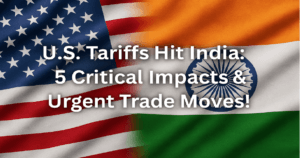U.S. Tariffs Hit India: 5 Critical Impacts & Urgent Trade Moves!
The Indian government is preparing for the impact of new U.S. tariffs but is unlikely to retaliate immediately as it continues negotiating a bilateral trade deal. These tariffs, set to take effect immediately, could be sector-specific or targeted at certain countries, affecting Indian exports, especially in agriculture and manufacturing. Rising prices in the U.S. may lead to reduced demand for Indian goods in the coming months, prompting exporters to brace for short-term disruptions. Some industries saw a surge in exports ahead of the announcement, as companies rushed to complete orders before the new trade barriers.
Experts believe the U.S. is using these tariffs as leverage in trade talks, given previous criticisms of India’s import duties. The Indian government is closely monitoring how these tariffs are calculated and their implications on trade policies. Commerce Minister Piyush Goyal emphasized that India’s tariff policies aim to protect domestic industries while enhancing global competitiveness. Meanwhile, India is pushing forward with other trade agreements to minimize long-term disruptions and maintain export growth.

U.S. Tariffs Hit India: 5 Critical Impacts & Urgent Trade Moves!
The Indian government is evaluating potential responses to new U.S. tariffs but has opted against immediate countermeasures as discussions for a bilateral trade agreement continue. This cautious approach reflects India’s focus on balancing short-term challenges with long-term diplomatic and economic goals.
U.S. Tariffs Take Immediate Effect
The White House has confirmed that the new tariffs will be enforced immediately after their announcement at 4 PM EST on Wednesday. While specifics remain unclear, the measures could target particular industries or nations. Notably, former President Donald Trump had previously hinted at imposing secondary tariffs on countries purchasing oil from Venezuela or other nations under U.S. trade sanctions. Indian authorities are closely examining the implementation details, including whether the tariffs will apply broadly or focus on select sectors.
Exporters Brace for Uncertainty
Indian businesses are concerned about reduced demand in the U.S. market, as higher tariffs could lead to increased prices for American consumers. In anticipation of this, industries such as jewelry and textiles rushed to ship orders ahead of the tariff deadline, resulting in a temporary surge in exports in March. Colin Shah, Managing Director of Kama Jewelry, noted this trend, explaining that while exports spiked last month, short-term disruptions are inevitable. However, he expressed optimism that a finalized India-U.S. trade deal could help stabilize bilateral commerce.
India’s Strategic Monitoring and Negotiation Tactics
New Delhi is closely monitoring how the U.S. structures these tariffs, particularly in light of Trump’s past criticisms of India’s import duties and trade practices. Analysts suggest that the U.S. may use heightened tariffs as leverage to push for concessions in ongoing negotiations. Key Indian exports—such as agricultural products, machinery, and pharmaceuticals—could face immediate impacts. To counter this, India is prioritizing trade discussions aimed at securing favorable terms, including reduced barriers for its goods in the U.S. market.
Domestic Policies to Strengthen Competitiveness
Commerce and Industry Minister Piyush Goyal recently emphasized that India’s tariff framework is designed to protect local industries, regulate trade imbalances, and enhance manufacturing efficiency. Over the past year, the government has lowered import duties on critical raw materials and intermediate goods—such as steel, chemicals, and electronic components—to reduce production costs for Indian manufacturers. This strategy aims to bolster global competitiveness, enabling industries to offer quality products at competitive prices despite external trade pressures.
Balancing Trade Relations and Economic Growth
While Indian exporters prepare for potential challenges, the government remains committed to sustaining export momentum. Officials are exploring new trade partnerships and diversifying markets to reduce reliance on the U.S., which accounts for nearly 18% of India’s total exports. At the same time, efforts to finalize the bilateral trade pact with Washington continue, with both sides negotiating terms related to digital trade, agricultural market access, and intellectual property rights.
Looking Ahead
The coming months will test India’s ability to navigate complex trade dynamics. While higher U.S. tariffs could impact certain sectors, the broader economic relationship remains strong. Bilateral trade reached a record $119 billion in 2023, underscoring mutual dependency. India’s focus on finalizing the trade deal—coupled with domestic reforms to boost manufacturing—could help cushion the impact of tariffs. Moreover, the government’s proactive engagement with industries to address concerns reflects a pragmatic approach to safeguarding economic interests.
In summary, India’s measured response highlights its strategic patience. By avoiding knee-jerk reactions and prioritizing dialogue, New Delhi aims to secure a balanced trade agreement that benefits both nations while insulating its economy from external shocks. As global trade dynamics evolve, India’s ability to adapt and negotiate will play a pivotal role in sustaining its growth trajectory.
You must be logged in to post a comment.